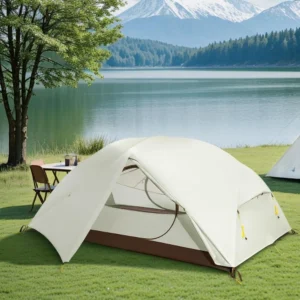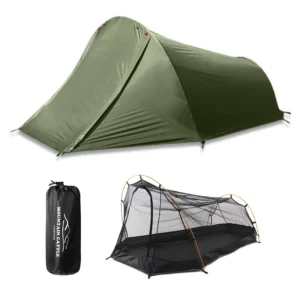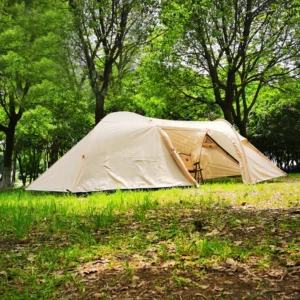Understanding Tent Material Durability: Key Factors That Matter
When investing in a tent, durability stands as one of the most critical considerations. But what exactly makes a tent material “durable,” and how can you determine which option best suits your needs?
Tent durability isn’t a simple one-dimensional measurement but rather a combination of several important resistance factors:
- Tear resistance: How well the fabric resists ripping when snagged or stressed
- Abrasion resistance: The fabric’s ability to withstand rubbing against rough surfaces
- UV resistance: How well it maintains strength and color when exposed to sunlight
- Water resistance: Its capacity to repel moisture and maintain structural integrity when wet
These durability factors directly impact your camping experience in multiple ways. A more durable tent typically lasts longer, performs better in challenging conditions, and provides greater peace of mind when you’re miles from civilization.
Several technical specifications determine how durable a tent material will be:
- Denier (D): A measurement of thread thickness – higher numbers generally indicate stronger fabric
- Thread count: The density of threads per square inch – tighter weaves typically provide better weather resistance
- Weave type: Structures like ripstop include reinforcement threads that prevent tears from spreading
- Coating types: Additional layers like silicone or polyurethane that enhance water resistance and durability
When evaluating comprehensive shelter options for two campers, remember that durability comes with trade-offs. Typically, more durable materials add weight, bulk, and cost. Finding the right balance depends on your specific needs and priorities.
It’s important to understand that there isn’t a single “most durable” tent material for all situations. The best choice depends on where you camp, how frequently you use your tent, and what specific conditions you face. Some materials excel in moisture resistance while others might offer superior UV protection or temperature regulation.
Decoding Technical Specifications: What Makes a Tent Fabric Tough
Understanding the technical aspects of tent materials helps you make informed decisions rather than relying solely on marketing claims. Let’s break down what truly makes a tent fabric tough.
Fiber Type
The base material forms the foundation of any tent’s durability profile:
– Nylon: Offers excellent strength-to-weight ratio and superior tear resistance
– Polyester: Provides better UV resistance and dimensional stability when wet
– Dyneema: Delivers unmatched strength at minimal weight, though at premium cost
– Cotton/Polycotton: Offers exceptional abrasion resistance and longevity with proper care
Denier (D)
This measurement indicates the thickness of individual threads used in the fabric. For tents:
– 15-30D: Ultralight but relatively delicate
– 40-70D: Good balance of durability and weight for most three-season use
– 70D+: Heavy-duty options for extreme conditions or extended use
For context, a 70D nylon typically offers approximately 40-50% more tear resistance than a 30D version of the same material, though at a weight penalty.
Thread Count
Higher thread counts create denser fabrics that generally offer improved:
– Weather resistance
– Tear strength
– Wind protection
– Insulation properties
Weave Patterns
The structure of how threads interlock significantly impacts performance:
– Ripstop: Features reinforcement threads in a grid pattern that prevent tears from spreading
– Oxford: A basketweave construction that enhances durability for high-wear areas like tent floors
– Plain weave: The simplest construction that balances strength, weight and cost
Coatings & Treatments
These additions enhance natural fabric properties:
– Polyurethane (PU): Creates waterproofing but degrades with UV exposure
– Silicone: Offers superior waterproofing, UV resistance, and extends fabric life
– DWR (Durable Water Repellent): Causes water to bead and roll off rather than saturating the fabric
Hydrostatic Head Rating
This measurement (in millimeters) indicates water resistance:
– 1,000mm: Resistant to light rain
– 1,500-3,000mm: Suitable for moderate rainfall
– 3,000mm+: Capable of handling sustained heavy precipitation
When mastering two-person lightweight tent setup, understanding these specifications helps you select the right balance between durability and portability. Even the most technically advanced waterproof backpacking tent requires appropriate care to maintain its protective properties.
Nylon: The Versatile Performer for Serious Campers
Nylon has dominated the premium tent market for decades due to its exceptional strength-to-weight ratio, making it particularly valuable for backpackers and mountaineers who count every ounce.
This synthetic material comes in several variants, each offering different performance characteristics:
– Nylon 6: The most common type used in tents, offering good overall durability
– Nylon 6.6: A higher-grade option with improved strength and heat resistance
– High-tenacity nylon: Specially engineered for maximum strength, often used in expedition tents
Nylon excels in several durability metrics that matter to outdoor enthusiasts:
– Outstanding tear strength compared to other lightweight fabrics
– Excellent abrasion resistance, particularly important for rocky terrain
– Good flexibility that helps absorb impact without tearing
To enhance performance, manufacturers typically apply protective coatings:
– Silicone coating (Silnylon): Premium waterproofing that extends fabric life and increases tear strength
– Polyurethane (PU) coating: More affordable waterproofing that’s somewhat less durable
PROS:
– Exceptional strength-to-weight ratio
– Superior tear resistance and tensile strength
– Excellent abrasion resistance
– Highly compressible for packability
– Takes well to waterproof coatings
CONS:
– Naturally vulnerable to UV degradation without protective treatments
– Absorbs water, causing sagging and increased weight when wet
– Typically costs more than polyester alternatives
– Requires more careful site selection to prevent damage
The weather resistance and durability of camping tents often relies heavily on nylon’s performance characteristics, especially in conditions where weight matters but strength cannot be compromised.
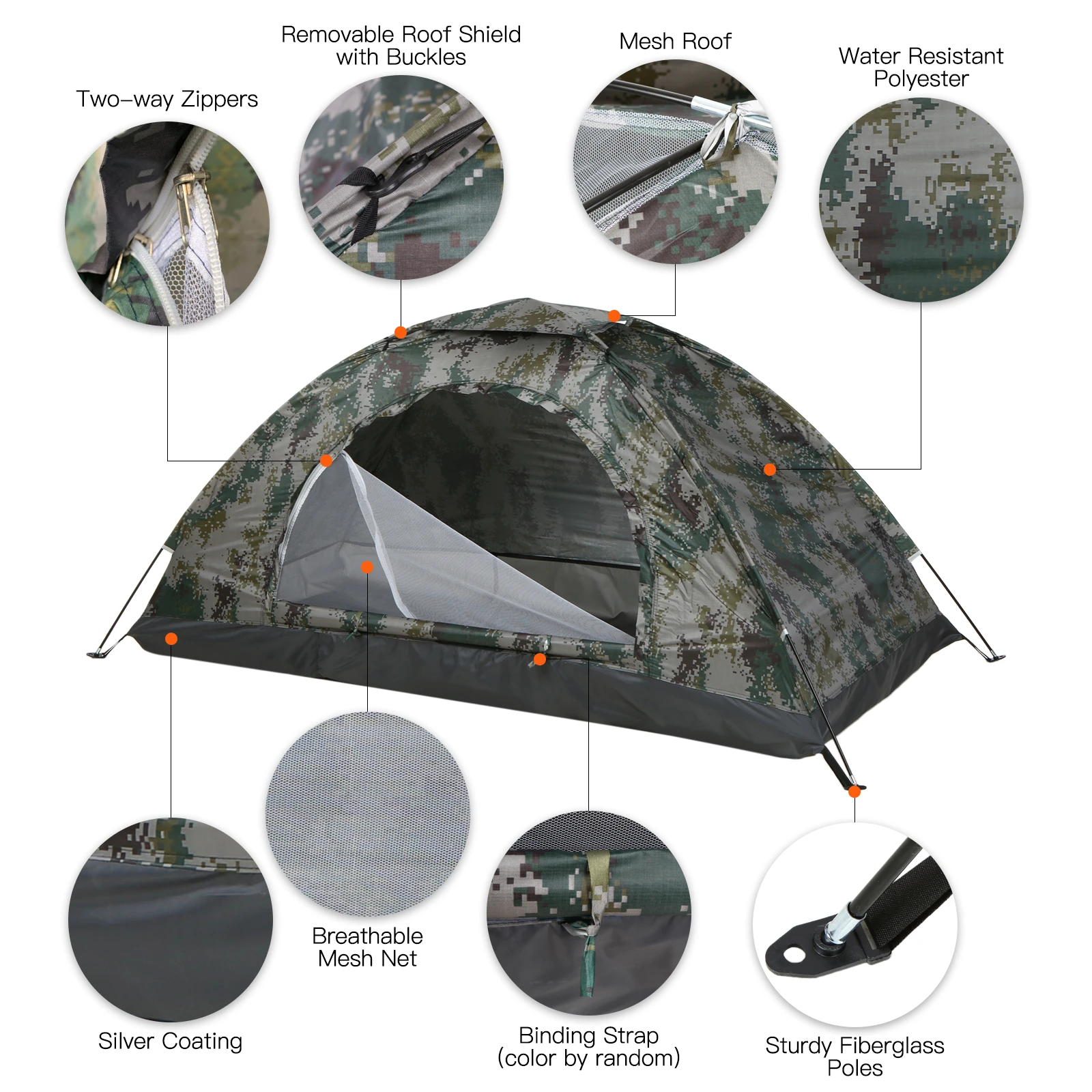
Polyester: The Budget-Friendly Workhorse
Polyester represents the most common tent material for recreational campers, offering a practical balance between durability, performance, and affordability. This synthetic fabric has steadily gained market share due to its practical advantages for typical camping scenarios.
Unlike nylon, polyester stands out for its inherent UV resistance—maintaining strength even after prolonged sun exposure. This makes polyester tents particularly suitable for:
– Extended setups at sunny campsites
– Family camping where the tent may remain pitched for several days
– Regions with intense sunlight exposure
Another significant advantage of polyester is its dimensional stability. When wet, polyester absorbs minimal water (about 0.4% of its weight compared to nylon’s 2.5-5%), resulting in:
– Minimal sagging during rainstorms
– More consistent tension and shape in humid conditions
– Less need for middle-of-the-night readjustments
Common treatments for polyester tents include:
– PU (polyurethane) coatings for waterproofing
– Acrylic coatings for enhanced water resistance
– UV inhibitors for additional sun protection
PROS:
– Superior resistance to UV degradation
– Minimal stretching or sagging when wet
– More affordable than equivalent nylon options
– Excellent color retention over time
– Generally requires less maintenance
CONS:
– Heavier than nylon for equivalent strength ratings
– Typically less tear-resistant than premium nylon fabrics
– Less tensile strength compared to equivalent denier nylon
– Not as compressible, requiring more pack space
For those considering different shelter options, the canvas shelter durability in rough weather offers an interesting comparison point with polyester’s performance characteristics in sustained exposure conditions.
Dyneema® Composite Fabric: The Ultralight Champion
Formerly known as Cuben Fiber, Dyneema Composite Fabric (DCF) represents the cutting edge of ultralight tent materials. Unlike traditional woven fabrics, DCF features a unique laminate construction:
– Ultra-high-molecular-weight polyethylene fibers sandwiched between polyester films
– Non-woven construction that eliminates the vulnerabilities of traditional weave patterns
– Sealed layers that create inherent waterproofing without additional coatings
This revolutionary construction results in truly remarkable performance characteristics:
– Strength-to-weight ratio up to 15 times stronger than steel
– Complete waterproofness with no need for additional treatments
– Exceptional UV resistance that far surpasses untreated nylon
DCF finds its primary application among:
– Ultralight backpackers and thru-hikers counting every ounce
– Adventure racers requiring maximum performance with minimal weight
– Those willing to invest significantly in the lightest possible shelter
PROS:
– Unmatched strength-to-weight ratio
– Inherently waterproof without coatings
– Zero water absorption
– Excellent UV resistance
– No stretch when wet
CONS:
– Extremely expensive (often 3-5 times the cost of quality nylon tents)
– Lower abrasion resistance than heavier fabrics
– Can be noisy in wind and rain
– Difficult to repair in the field
– Less flexible packing due to crease memory
Many ultralight trekking pole tent designs utilize DCF specifically because of its incredible weight savings while maintaining structural integrity—a critical combination for minimalist hikers covering long distances.
Canvas & Polycotton: Old-School Durability Champions
Before synthetic fabrics dominated the market, canvas was the original tent material—and for good reason. Modern canvas and polycotton (polyester-cotton blend) tents continue to offer exceptional durability benefits that synthetic alternatives struggle to match.
Traditional cotton canvas and newer polycotton blends create a distinctive camping experience through:
– Natural fiber construction that breathes with changing conditions
– Tight weave that swells when wet to create natural waterproofing
– Dense material that blocks light and dampens sound
From a durability standpoint, properly maintained canvas excels in:
– Exceptional abrasion resistance that withstands years of rough handling
– Outstanding tear strength when properly reinforced
– Remarkable puncture resistance compared to lighter synthetics
– Natural UV protection that lasts for decades with proper care
These materials particularly shine for:
– Glamping and semi-permanent setups
– Hot, dry climates where breathability matters
– Four-season camping where insulation becomes important
– Situations where noise reduction improves sleep quality
PROS:
– Exceptional longevity with proper maintenance
– Superior breathability reducing condensation
– Natural temperature regulation (cooler in heat, warmer in cold)
– Excellent noise dampening during wind and rain
– Develops character and improved waterproofing over time
CONS:
– Extremely heavy (often 2-4 times heavier than synthetic equivalents)
– Bulky even when packed
– Vulnerable to mold and mildew if stored damp
– Requires “weathering” before achieving full waterproofness
– Significantly longer drying time after rain
For those prioritizing comfort and durability over weight and packability, canvas camping tents offer a premium experience with proper care, often lasting decades rather than years.
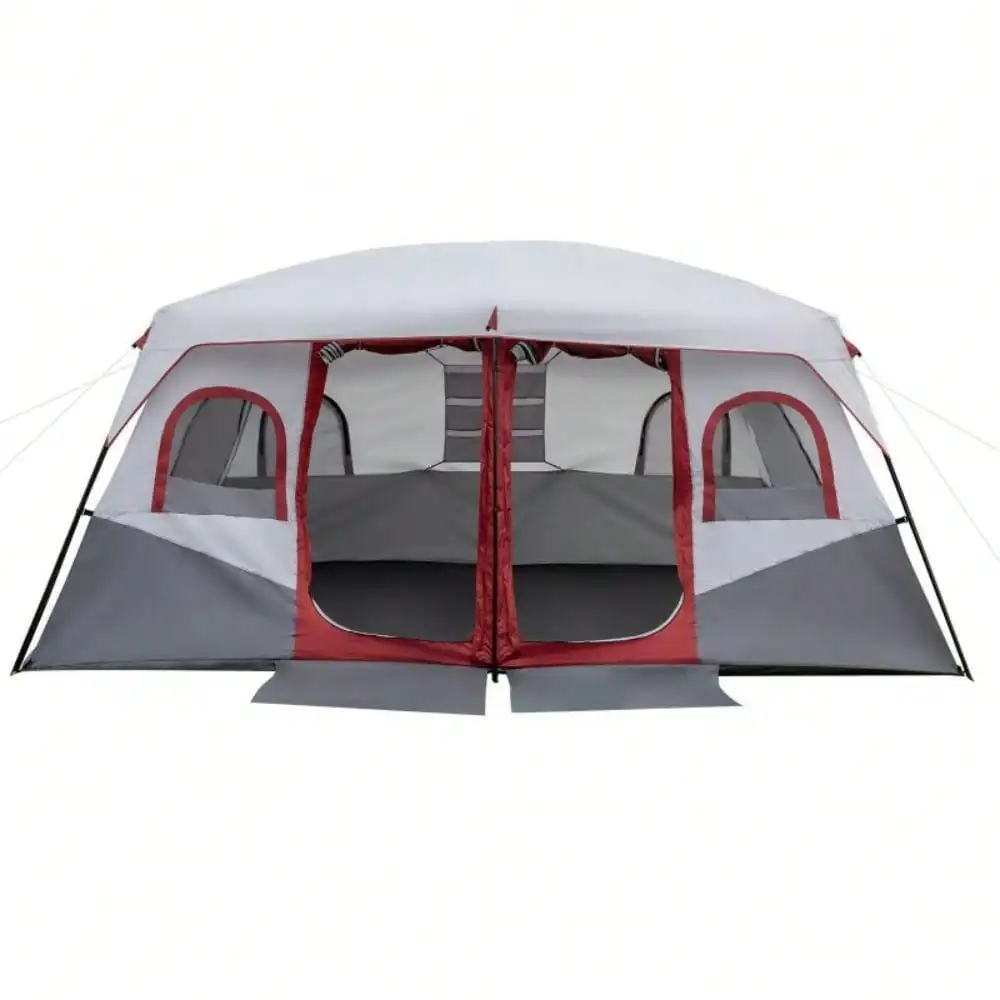
Comparative Analysis: Durability Face-Off Between Materials
When selecting the most durable tent material for your needs, direct comparisons across key performance metrics help clarify the trade-offs involved. Each material presents a different profile of strengths and weaknesses:
| Material | Tear Strength | Abrasion Resistance | UV Resistance | Water Resistance | Weight | Expected Lifespan | Relative Cost |
|---|---|---|---|---|---|---|---|
| Nylon | Excellent | Very Good | Poor-Moderate* | Very Good** | Light | 5-10 years | Moderate-High |
| Polyester | Good | Good | Very Good | Good | Moderate | 5-8 years | Low-Moderate |
| DCF (Dyneema) | Excellent | Fair | Excellent | Excellent | Ultralight | 3-7 years*** | Very High |
| Canvas/Polycotton | Very Good | Excellent | Excellent | Good**** | Very Heavy | 10-20+ years | High |
With UV inhibitor treatments, nylon UV resistance improves significantly
With silicone coating (silnylon)
Limited by abrasion resistance rather than material failure
**After proper weathering
The durability equation involves important trade-offs:
– Weight reduction typically sacrifices some aspect of durability
– Higher initial cost often (but not always) correlates with longer lifespan
– Materials with specialized strengths often have corresponding weaknesses
When considering long-term value, the cost-per-year metric reveals interesting insights:
– A $200 polyester tent lasting 5 years costs $40/year
– A $500 high-quality nylon tent lasting 10 years costs $50/year
– A $1,000 canvas tent lasting 20 years costs $50/year
Finding the right balance requires honestly assessing your camping shelter options for two people and determining which durability factors matter most for your specific adventures.
Beyond Fabric: Construction Features That Enhance Tent Durability
While fabric selection forms the foundation of tent durability, construction details often determine how well that material performs in real-world conditions. Even the most premium material can fail if poorly assembled.
Seam Construction
The way fabric panels connect creates potential weak points:
– Flat-felled seams: Provide maximum strength by folding fabric edges together before stitching
– Taped seams: Add waterproof strips covering needle holes from stitching
– Double-stitched seams: Add redundancy to prevent failure if one thread breaks
– Welded seams: Use heat-bonding rather than stitching for waterproof connections
Stress Point Reinforcement
Critical areas that bear the most load require special attention:
– Bar tacking (dense stitching) at pole attachment points
– Extra fabric layers at corners and guyline connections
– Reinforced stake loops with webbing or heavier material
– Strategic pole structure design to distribute tension evenly
Pole Materials and Design
The skeleton of the tent significantly impacts durability:
– Aluminum poles offer better strength-to-weight ratio than fiberglass
– DAC aluminum poles set the industry standard for premium tents
– Pole diameter affects wind stability (thicker = stronger)
– Hub designs distribute stress more evenly than simple pole crossings
Zipper Quality and Protection
These high-wear components deserve special attention:
– YKK zippers (particularly #8 or #10 size) offer superior reliability
– Storm flaps protect zippers from moisture and UV exposure
– Double sliders provide backup functionality if one fails
– Anti-snag design reduces fabric catching and zipper damage
Tent Architecture
The basic tent shape affects structural integrity:
– Dome camping tents distribute stress evenly across the fabric
– Geodesic designs with pole crossings provide superior stability in wind
– Tunnel tents require proper tensioning but excel in space efficiency
– Minimalist designs reduce potential failure points but offer less weather protection
These construction elements work together with fabric quality to determine true durability. Even the most robust material will underperform if poorly implemented in the final design.
Matching Materials to Your Adventure Type
Different camping styles and environments demand specific durability characteristics. Matching tent materials to your particular adventure type ensures you get the protection you need without carrying unnecessary weight or spending more than required.
Ultralight Backpacking
When every ounce matters but shelter remains essential:
– Ideal materials: DCF or lightweight silnylon (15-30D)
– Key durability factors: Tear strength, minimal water absorption
– Compromise areas: Abrasion resistance, longevity
– Site selection importance: Critical (careful placement minimizes material stress)
Mountaineering/Expedition
For extreme conditions where shelter failure isn’t an option:
– Ideal materials: High-tenacity nylon (50-70D+) with quality silicone coating
– Key durability factors: Wind resistance, snow loading capacity, UV protection
– Compromise areas: Weight, pack size
– Extra features: Reinforced pole sleeves, multiple guylines, robust stakes
Family/Car Camping
When weight matters less than comfort and value:
– Ideal materials: Polyester (68-75D) with quality PU coating
– Key durability factors: UV resistance, ease of cleaning, simple repairs
– Compromise areas: Premium lightweight materials unnecessary
– Extra features: Separate groundsheet, larger vestibules, multiple doors
Glamping/Long-Term Setup
For semi-permanent installations prioritizing comfort:
– Ideal materials: Canvas or polycotton blends
– Key durability factors: Abrasion resistance, breathability, long-term UV exposure
– Compromise areas: Weight, pack size, dry time
– Extra features: Standing height, multiple rooms, stove jack options
Environmental factors also significantly impact material selection:
– Desert camping requires exceptional UV resistance (polyester or treated canvas)
– Tropical conditions demand excellent ventilation and mold resistance
– Alpine environments require materials that perform well in extreme temperature fluctuations
– Coastal camping benefits from corrosion-resistant components and saltwater-resistant fabrics
For specialized needs like winter camping, 4-season winter 2-person tents combine material durability with architectural features designed specifically for harsh conditions.
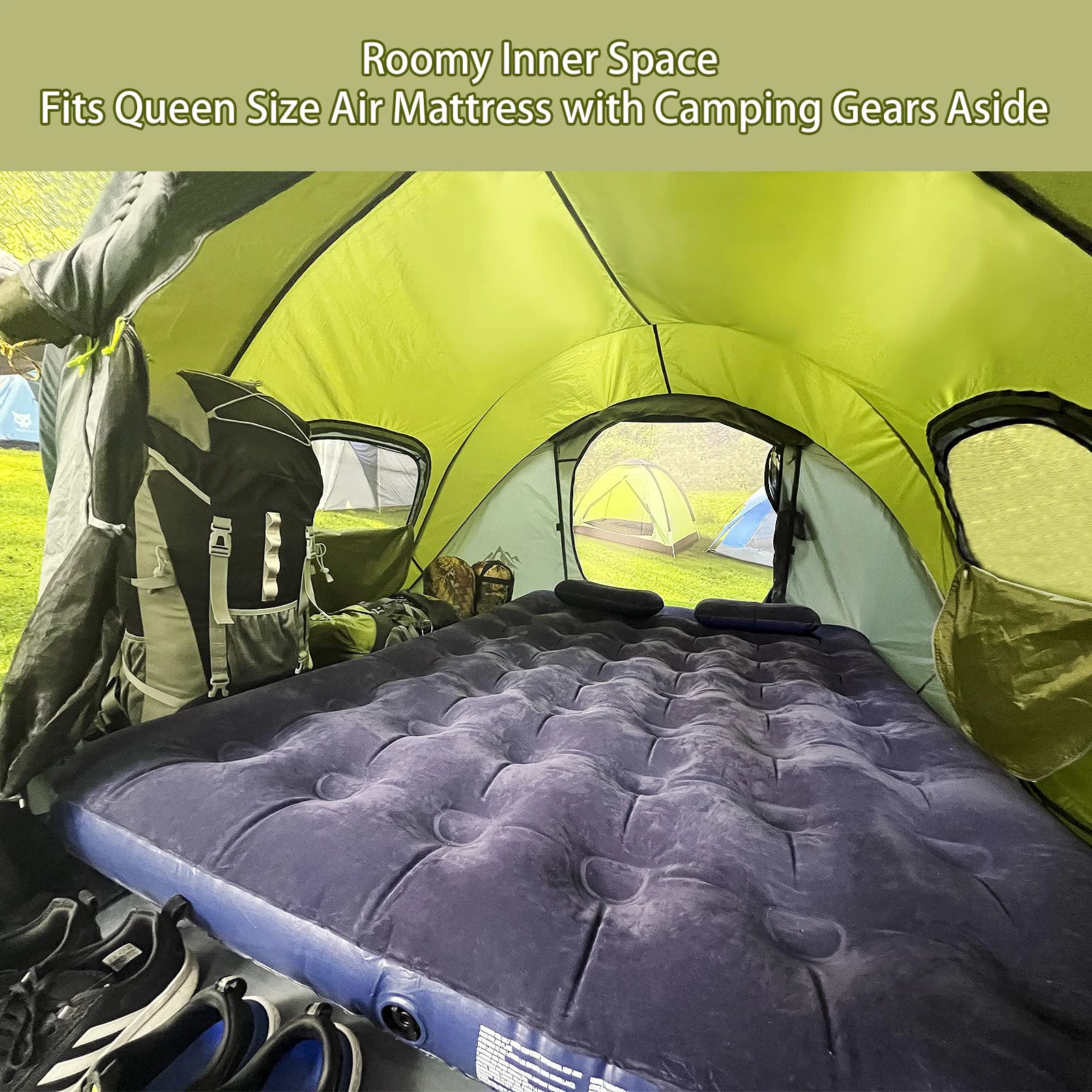
Maximizing Lifespan: Essential Care Tips for Every Tent Material
Even the most durable tent materials require proper maintenance to reach their full potential lifespan. Following these essential care practices can significantly extend your tent’s durability regardless of material:
Site Selection and Preparation
– Clear away sharp objects, sticks, and stones before setup
– Use a footprint or groundsheet sized slightly smaller than your tent floor
– Avoid setting up directly under trees that drop sap or sharp debris
– Select naturally cushioned surfaces when possible (grass, pine needles)
– Position tent to minimize direct UV exposure during peak hours
Setup Techniques for Durability
– Maintain even tension across all sides to prevent stress concentration
– Use all provided stake points and guy lines in windy conditions
– Avoid over-tensioning, which can stress seams and zippers
– Enter and exit at designated doorways rather than leaning against walls
Material-Specific Cleaning
– Nylon/Polyester: Spot clean with mild soap and cold water
– Canvas: Brush off dry dirt; never machine wash; use specialized canvas cleaners for stains
– DCF: Gentle wiping with water; avoid abrasive scrubbing
– All materials: Never use bleach, strong detergents, or washing machines
Proper Drying and Storage
– Always pack completely dry to prevent mold and mildew
– Canvas requires thorough drying, potentially taking several days
– Store loosely in breathable storage bags, not tight compression sacks
– Keep in cool, dry place away from direct sunlight
– Hang or loosely fold for long-term storage rather than compressed packing
UV Protection Strategies
– Set up in shade when possible during multi-day stays
– Consider UV-blocking sprays for nylon tents without built-in protection
– Take down during day if possible during extended stays
– Use rain flies even in clear weather as UV shields
Field Repair Techniques
– Carry appropriate repair items: tape for synthetic fabrics, waxed thread for canvas
– Address small tears immediately before they expand
– Apply seam sealer annually to maintain waterproofing
– Replace guylines showing wear before they fail
With proper care, a quality tent can last 30-50% longer than one that receives minimal maintenance. This makes care practices as important as initial material selection when considering long-term durability and value.
For comprehensive guidance on maintaining tent performance in challenging conditions, the best all-season tent performance durability value resource provides additional material-specific recommendations.
Lightweight Backpacking Tent, Ultralight Backpacking Tent, Waterproof Backpacking Tent
$391.05 Select options This product has multiple variants. The options may be chosen on the product pageHeavy Duty 4 Season Tent, Mountaineering Tent, Winter Camping Tent
$870.40 Select options This product has multiple variants. The options may be chosen on the product pageCompact Backpacking Tent, Lightweight Backpacking Tent, Waterproof Camping Tent
$335.52 Select options This product has multiple variants. The options may be chosen on the product pageUltralight Backpacking Tent, Ultralight Dome Tent, Winter Camping Tent
Price range: $369.63 through $370.07 Select options This product has multiple variants. The options may be chosen on the product pageCamping Tent with Vestibule, Waterproof Camping Tent
Price range: $407.89 through $479.48 Select options This product has multiple variants. The options may be chosen on the product pageHeavy Duty 4 Season Tent, Ultralight Freestanding Tent, Winter Camping Tent
$3,722.66 Select options This product has multiple variants. The options may be chosen on the product page
Innovations in Tent Materials: What’s Coming Next
The quest for more durable, lighter, and more sustainable tent materials continues to drive innovation in the outdoor industry. Several emerging technologies promise to reshape what we expect from tent durability:
Advanced Synthetic Materials
– Graphene-infused fabrics offering unprecedented strength-to-weight ratios
– Biomimetic materials that adapt to environmental conditions
– Hybrid fabrics combining the best properties of multiple fiber types
– Ultra-high-tenacity polyesters approaching nylon’s strength at lower weights
Sustainable Durability Solutions
– Recycled nylon and polyester that perform comparably to virgin materials
– PFC-free waterproof coatings that reduce environmental impact
– Bio-based polymers derived from renewable resources rather than petroleum
– Fabrics designed for eventual biodegradability without compromising performance
Enhanced Coating Technologies
– Multi-layer coatings that address multiple durability challenges simultaneously
– Self-healing treatments that can repair minor damage automatically
– Longer-lasting DWR treatments that maintain performance without frequent reapplication
– UV-resistant coatings that extend fabric life in high-exposure conditions
These innovations are addressing traditional durability challenges in creative ways:
– Reducing the weight penalties typically associated with durable materials
– Extending the useful lifespan of ultralight fabrics
– Improving breathability without sacrificing weather protection
– Creating more environmentally responsible options without performance compromises
For those interested in the cutting edge of tent technology, mountaineering tents often showcase the latest material innovations first, as their extreme-condition requirements drive development before features trickle down to mainstream camping equipment.
Making Your Decision: Questions to Ask When Evaluating Tent Durability
When determining the most durable tent material for your specific needs, consider these key questions to guide your decision:
What weather conditions will you typically face?
Different materials excel in different environments. Polyester stands up better to sustained UV exposure, while high-quality nylon often performs better in variable conditions requiring strength and flexibility. Canvas provides excellent insulation in temperature extremes but requires more maintenance in wet conditions.
How frequently will you use your tent?
Occasional campers (5-10 nights yearly) can often prioritize other factors over maximum durability. Frequent users (20+ nights yearly) should invest in materials matched to their specific usage patterns. Consider that usage frequency significantly impacts the value equation of premium materials.
How much weight are you willing to carry?
The most durable materials often come with weight penalties. Be honest about how far you’ll carry your shelter and how much weight impacts your enjoyment. Car campers can prioritize durability without weight concerns, while backpackers need to balance protection with portability.
What’s your budget for initial investment vs. long-term value?
Higher upfront costs often (but not always) translate to better durability and longer lifespan. Consider cost-per-use rather than just purchase price. A $500 tent used 100 times costs $5 per use, while a $200 tent used 30 times costs $6.67 per use.
How important is ease of setup and maintenance?
Some durable materials require more care and maintenance. Canvas needs proper weathering and drying, while DCF requires gentle handling to prevent abrasion damage. Synthetic materials generally offer easier maintenance but may need more frequent replacement.
When choosing the ultimate compact shelter for two, balancing these factors against your specific needs will lead to the most satisfying long-term decision.
Our Top Recommendations for Durable Tent Materials
Based on our comprehensive analysis, here are our recommendations for the most durable tent materials across different scenarios:
For Maximum Overall Durability Regardless of Weight:
Heavy-duty canvas or polycotton blends stand unmatched for sheer longevity when properly maintained. These materials can last decades with appropriate care and offer exceptional resistance to abrasion, tears, and UV damage. They excel in harsh conditions where reliability trumps portability.
For Best Durability-to-Weight Ratio:
High-tenacity nylon (50-70D) with quality silicone coating (silnylon) provides the optimal balance between strength and packability. This material offers excellent tear resistance and performance across varied conditions without excessive weight penalties. DCF (Dyneema) offers even better strength-to-weight but at significantly higher cost and with reduced abrasion resistance.
For UV Durability:
Quality polyester with built-in UV inhibitors provides the most reliable long-term performance in sunny environments. While not as inherently strong as equivalent nylon, its superior resistance to sun damage makes it the better choice for extended exposure or desert camping where solar degradation poses the primary threat.
For Abrasion Resistance:
For floor materials and high-wear areas, high-denier nylon oxford (150-300D) with reinforced coatings offers the best protection against ground contact damage. This specialized material prevents the punctures and tears that often cause tent failure, especially important for rocky or rough terrain.
For Best Value Durability:
Quality polyester (68-75D) with reliable PU coating offers the most practical durability for most recreational campers. Its balanced performance across most conditions, reasonable cost, and minimal maintenance requirements make it the sensible choice for families and occasional adventurers.
Remember that true durability comes from matching material to intended use. For specific performance requirements, consider exploring our waterproof camping tent collection, which features materials selected for their durability and weather resistance across various conditions and applications.
At Explore Elements, we believe the most durable tent is ultimately the one that reliably meets your specific needs trip after trip, regardless of what challenges nature presents. By understanding material properties and matching them to your adventure style, you’ll make an investment that delivers years of memorable outdoor experiences.


